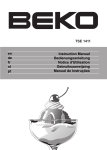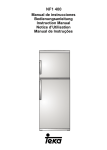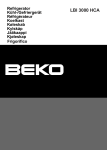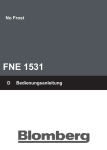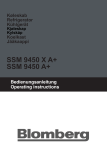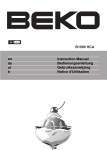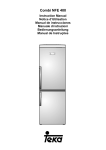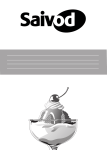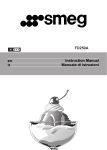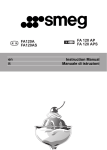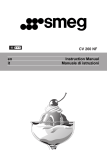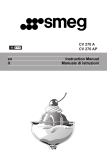Download Teka TSE 342 User's Manual
Transcript
TSE 342 TSE 342 A Manual de instrucciones Bedienungsanleitung Instruction Manual Notice d’Utilisation Manual de Instruções Manuale di istruzioni de-Inhalt 1-13 pt-Índice 1-13 Wichtige Hinweise zu Ihrer Sicherheit!....../1 Transporthinweise ...................................../2 Entsorgung ................................................/2 Aufstellung des Gerätes............................/2 Lernen Sie Ihr neues Gerät kennen ........../3 So verwenden Sie das Zubehör................/3 Vor der ersten Inbetriebnahme ................./3 Einstellen der Betriebstemperatur ........../3-5 Kühlen ......................................................./6 Abtauen des Gerätes (frische Lebensmittel)./6 Gefrieren .................................................../7 Abtauen des Gerätes (gefrorene Lebensmittel)............................................./7 Austausch der Innenbeleuchtungsglühbirne./8 Reinigung und Pflege................................/8 Praktische Tipps und Hinweise ................./9 Anwendungsbeispiele............................../10 Normale Betriebsgeräusche ..................../10 Was mache ich, wenn... ........................../11 Türanschlag umkehren............................/12 Bedeutung der Energieeffizienzinformation ./13 A segurança está sempre em primeiro lugar! .........................................../1 Instruções de transporte .........................../2 Eliminação................................................./2 Configuração do Equipamento................../2 Conheça o seu equipamento ..................../3 Como utilizar os acessórios ....................../3 Antes de colocar em funcionamento........./3 Ajustar a temperatura de funcionamento.../3-5 Arrefecimento ............................................/6 Descongelação do equipamento (Alimentos frescos) .................................../6 Congelar..................................................../7 Descongelação do equipamento (Alimentos congelados)............................./7 Substituição da lâmpada interior.............../8 Limpeza e cuidados ................................../8 Notas e dicas práticas .............................../9 Exemplos de utilização............................/10 Ruídos normais de funcionamento........../10 O que fazer se.... ...................................../11 Inverter as portas...................................../12 Significado da ficha de energia ............../13 fr-Index es-Índice 1-13 La sécurité d'abord !................................../1 Instructions de transport............................/2 Mise au rebut ............................................/2 Installation de l'appareil............................./2 Apprendre à connaître votre appareil......../3 Comment utiliser les accessoires............../3 Avant la mise en service .........................../3 Réglage de la température de fonctionnement........................................../3-5 Réfrigération............................................../6 Dégivrage de l'appareil (produits frais)....../6 Congélation .............................................../7 Dégivrage de l'appareil (produits congelés)..................................../7 Remplacer l'ampoule intérieure................./8 Nettoyage et entretien.............................../8 Conseils pratiques et remarques ............../9 Exemples d'utilisation................................/10 Bruits normaux de fonctionnement .........../10 Et si…......................................................../11 Réversibilité des portes ............................./12 Signification de la fiche énergétique ........./13 en-Index 1-13 Safety comes first !..................................../1 Transport instructions................................/2 Disposal ..................................................../2 Appliance Setup ......................................../2 Get to know your appliance......................./3 How to use the accessories ....................../3 Prior to startup.........................................../3 Setting the operating temperature........../3-5 Cooling ....................................................../6 Defrosting of the appliance (Fresh Food)../6 Freezing ..................................................../7 Defrosting of the appliance (Frozen Food)/7 Replacing the interior light bulb................./8 Cleaning and care ...................................../8 Practical tips and notes ............................./9 Examples of use ....................................../10 Normal operating noises ........................../10 What, if.... ................................................/11 Reversing the doors ................................/12 Meaning of energy fiche ......................../13 1-13 La seguridad es lo primero......................../1 Instrucciones de transporte......................./2 Eliminación ................................................/2 Ajuste del electrodoméstico ....................../2 Detalles del electrodoméstico .................../3 Cómo utilizar los accesorios ...................../3 Antes de empezar ...................................../3 Ajuste de la temperatura de funcionamiento /3-5 Refrigeración ............................................./6 Deshielo del electrodoméstico (alimentos frescos) ..................................../6 Congelación ............................................../7 Deshielo del electrodoméstico (alimentos congelados) ............................./7 Sustitución de la bombilla interior ............./8 Conservación y limpieza .........................../8 Notas y consejos útiles ............................./9 Ejemplos de utilización ............................/10 Ruidos normales de funcionamiento ......./10 Resolución de problemas ......................../11 Inversión de las puertas ........................../12 Significado de la ficha de energía .........../13 it-Indice 1-13 Innanzitutto la sicurezza!.........................../1 Istruzioni per il trasporto .........................../2 Smaltimento ............................................../2 Installazione dell'elettrodomestico............./2 Conoscere l'elettrodomestico ..................../3 Modalità di utilizzo degli accessori ............/3 Prima dell'avvio ........................................./3 Impostazione della temperatura di funzionamento......................................../3-5 Raffreddamento........................................./6 Sbrinamento dell'elettrodomestico (cibi freschi) .............................................../6 Congelamento .........................................../7 Sbrinamento dell'elettrodomestico (cibi congelati) .........................................../7 Sostituzione della lampadina interna ......../8 Pulizia e manutenzione ............................./8 Suggerimenti pratici e note ......................./9 Esempi di utilizzo...................................../10 Rumori normali durante il funzionamento/10 Cosa fare, se…......................................../11 Inversione degli sportelli ........................../12 Significato della scheda sull'energia ......../13 1 16 17 2 3 (TSE 342) 4 16 5 A 4 4 6 7 8 9 18 10 11 12 B 13 13 14 15 Fig. 1 f b d Fig. 2 h m g quick freeze l e quick fridge j i k a c Fig. 3 Fig. 4 Fig. 5 Fig. 6 Fig. 7 en en Congratulations on your choice of our product which will certainly provide you with many years of good service. Safety comes first! Please read this Instruction Manual carefully. It contains important information on how to use your new appliance. If instructions are not adhered to, you may lose your right to service at no charge during the warranty period. Please keep this manual in a safe place and pass it on to later users if applicable. • Do not connect your appliance to the power supply until all packing and transit protectors have been removed. • Leave to stand upright for at least 4 hours before switching on to allow the system to settle if transported horizontally. • This appliance must only be used for its intended purpose, i.e. the storing and freezing of edible foodstuff. • We do not recommend use of this appliance in an unheated, cold room e.g. garage, conservatory, annex, shed, outdoors, etc. See ‘Location’. • On delivery, check to make sure that the product is not damaged and that all the parts and accessories are in perfect condition. • Do not operate a damaged appliance; if in doubt, check with your dealer. • Do not allow children to play with the appliance. • Do not sit or stand on or let the children sit or stand on the appliance or on the pull-out parts. • Do not hang on the appliance door. • Your appliance contains no fluoridated coolants (CFC/HFC), but isobutane (R 600 a), a natural gas which is highly compatible with the environment. (R 600 a) is easily flammable. Therefore, be sure that the cooling circuit is not damaged either during transport or during operations. In the event of damage; • Avoid any open flame, sources of sparks and flammable substances. • Immediately air the room in which the appliance is located. • In case the coolant spraying out contacts your eyes it may cause eye injuries. • The space in the room where the appliance is installed must not be smaller than 10 cubic metres. • Do not dispose of the appliance in a fire. Your appliance contains non CFC substances in the insulation which are flammable. • Please contact the local authority in your region for information on disposal methods and facilities available. Warning - Keep ventilation openings on the appliance enclosure or in the built-in structure, clear of obstruction. Warning - Do not use mechanical devices or other means to accelerate the defrosting process, other than those recommended by the manufacturer. Warning - Do not damage the refrigerant circuit. Warning - Do not use electrical devices inside the food storage compartments of the appliance, unless they are of the type recommended by the manufacturer. • Avoid touching the metal condenser wiring on the backside of the appliance; there is risk of injury. • In the event of a possible malfunction, disconnect the appliance from the power supply first. • Prior to cleaning the appliance always unplug the appliance or switch off the circuit breaker. Do not pull from the power cable. Pull from the plug. • Repairs to the electrical equipment may only be made by qualified experts. If the power cable is damaged, the manufacturer or customer service must replace it in order to avoid danger. 1 en en Transport instructions Location The appliance should be transported only in upright position. The packing as supplied must be intact during transportation. If the appliance is transported in the horizontal position, it must be placed vertically and left in this position for 4 hours before taking into operation. The appliance must be protected against rain, moisture and other atmospheric influences. The manufacturer assumes no liability if safety instructions are disregarded. Only place the appliance, as shown in the illustration in dry rooms which can be aired. Avoid direct sunlight or direct heat sources such as a stove or a heater. If this cannot be avoided, the following minimum distances should be maintained: Electric stoves: 3,00 cm Heater: 3,00 cm Cooling devices: 2,50 cm • Ensure sufficient air circulation for your device. • Make sure that sufficient room is provided around the appliance to ensure free air circulation. Fit the two plastic wall spacers supplied with the appliance rotating 1/4 turn to the condenser at the back of the appliance (Fig. 5). • The appliance should be located on a smooth surface. The two front feet can be adjusted as required. To ensure that your appliance is standing upright adjust the two front feet by turning clockwise or counter-clockwise, until the product is in firm contact with the floor. Correct adjustment of feet avoids excessive vibration and noise. Disposal Make the appliance unusable immediately. Pull out the mains plug and cut the power cable. Remove or destroy snap or latch locks before disposing of the appliance. In this manner you prevent children from locking themselves in and endangering their lives. Appliance setup Electrical connections • Do not operate your appliance in a room where the temperature is likely to fall below 10 °C at night and/or especially in winter. At lower temperatures the appliance may not operate, resulting in a reduction in the storage life of the food. Warning This appliance must be grounded. • Check whether the power type and voltage in your region corresponds to the one stated on the rating label inside the appliance. • The electrical safety of the appliance is only assured when the grounding system in the house is installed in accordance with regulations. • When placing the appliance, do not let the power cable get stuck under it; otherwise the cable will be damaged. • Ensure that the plug remains readily accessible. Do not use a multiple adapter bar or an extension cable. • The electrical specifications of your appliance is given on the rating label located inside the appliance. • Route power cable to allow easy connection and disconnection after installation. • A contact separator should be used if the power cable is not accessible. (for built-in models) • The climate class rate of your appliance is given on the rating label located inside the appliance. It specifies the appropriate operating ambient temperatures as explained below. Climatic class Ambient temperatures SN.......................+10 °C to 32 °C N .........................+16 °C to 32 °C ST .......................+18 °C to 38 °C T..........................+18 °C to 43 °C SN-ST .................+10 °C to 38 °C SN-T ...................+10 °C to 43 °C 2 en en Get to know your appliance Prior to startup Before you begin operating your appliance, the following points should be re-checked for safety: Warning Below information about accessories are supplied only for reference. Below accessories may not be exactly same as the accessories of your appliance. • Is the appliance standing properly on the floor? • Is there sufficient space for good air circulation? • Is the interior clean? (Also see the section “Cleaning and care”) • Now connect the appliance to the mains. Fig. 1 A) Fridge compartment B) Freezer compartment 1. 2. 3. 4. 5. 6. 7. 8. 9. 10. 11. 12. 13. 14. 15. 16. 17. 18. Control panel Interior light Fan Movable shelves Wine rack Defrost water collection channel - Drain tube Salad crisper Crisper cover Fresh zone compartment cover Fresh zone compartment Ice bank Fast freeze compartment Freezer compartment Air grille Adjustable front feet Adjustable door shelves Egg tray Bottle shelf The compressor is turned on; the interior light comes on when the Fridge door is opened. Do not place foodstuff into the refrigerator until the temperature has reached the desired level. Setting the operating temperature (Fig. 2) Control Panel: Control Functions Considering Figure.2, the following functions are implemented on the appliance. a) Fridge Set and Vacation b) Freezer Set c) Quick Fridge d) Quick Freeze e) Actual Fridge Temperature f) Actual Freezer Temperature g) Fridge Bar Graphs h) Freezer Bar Graphs i) Vacation Icon j) Economy Icon k) Quick Fridge Icon l) Quick Freeze Icon m)Alarm Icon 3 en en Description of the Control Functions c) Quick Fridge a) Fridge Set and Vacation This button is designed for fast cooling of the fridge. Press quick fridge button to start the function. The quick fridge icon will light on when the function is activated. Each time the quick fridge function is activated, “1” blinks on the display for 5 seconds only. Then the actual fridge temperature will be shown. Quick fridge function lasts for maximum 3 hours. When the quick fridge function is completed, quick fridge icon will light off automatically and the previous fridge set temperature will be recalled. The desired fridge temperature of the appliance can be adjusted by using fridge set button. To change the fridge set temperature press the fridge set button. The first time the button is pressed the current set temperature is shown on the display then afterwards, each time the button is pressed the new fridge set temperature will be displayed in sequence: 4, 2, 8, 6, 4, … The fridge set temperature will blink on the display for 5 seconds only. Then the actual fridge temperature will be shown. Quick fridge function terminates automatically in 3 hours. To deactivate quick fridge function manually, it is enough to press quick fridge button once more or fridge set button. Quickfreeze and quick fridge functions cannot be active at the same time. Therefore, pressing quick freeze button also deactivates quick fridge function. Vacation: The fridge compartment temperature can be adjusted around 13°C. When the fridge compartment is empty, vacation function can be activated if desired. The use of this function will save some power. The electronic control system incorporates a safety protection so that if the quick fridge button is pressed more than once in a short time, then the compressor will not run immediately. In order to preserve temperature inside the fridge compartment, the fridge door should be kept closed during vacation function. Otherwise, the door open alarm will be active within a minute and the interior light of the fridge compartment will light on. d) Quick Freeze To activate vacation function, it is enough to press the fridge set button for about 3 seconds. Then the vacation icon on the display will light on. This button is designed for fast cooling of the freezer. Press quick freeze button to start the function. The quick freeze icon will light on when the function is activated. Each time the quick freeze function is activated, “-27” blinks on the display for 5 seconds only. Then the actual freezer temperature will be shown. Quick freeze function lasts for maximum 32 hours. When the quick freeze function is completed, quick freeze icon will light off automatically and the previous fridge set temperature will be recalled. To deactivate vacation function, it is enough to press Quick Fridge or Fridge Set buttons. b) Freezer Set The desired freezer temperature of the appliance can be adjusted by using freezer set button. To change the freezer set temperature press the freezer set button. The first time the button is pressed the current set temperature is shown on the display then afterwards, each time the button is pressed the new freezer set temperature will be displayed in sequence: -18, -20, -22, -24, -18, … Quick freeze function terminates automatically in 32 hours. To deactivate quick-freeze function manually, it is enough to press quick freeze button once more or freeze set button. Quickfreeze and quick fridge functions cannot be active at the same time. Therefore, pressing quick fridge button also deactivates quick freeze function. The freezer set temperature will blink on the display for 5 seconds only. Then the actual freezer temperature will be shown. If large amounts of fresh food is going to be 4 en en h) Freezer Bar Graphs (Fig. 2/h) frozen, push the quick freeze button 8 hrs. before putting the fresh food in the freezer compartment. The electronic control system incorporates a safety protection so that if the quick freeze button is pressed more than once in a short time, then the compressor will not run immediately. The number of bars lighting on the freezer bar graphs are determined considering the freezer set temperature. If the freezer set temperature is -24; then all the freezer bars light on. If the freezer set temperature is -22; then min icon and 12 bars light on. If the freezer set temperature is -20; then min icon and 10 bars light on. If the freezer set temperature is -18; then min icon and 6 bars light on. e) Actual Fridge Temperature The average temperature of the packages inside the fridge compartment is shown here. Accordingly, this temperature is not sensitive to instantaneous temperature changes. The fridge set temperature blinks here for 5 seconds when the fridge set temperature is adjusted. If quick freeze is active; then all freezer bars light on also. i) Vacation Icon When quick fridge button is pressed, “1” is displayed also here. This part is not active when the vacation function is running. The vacation icon indicates that the vacation function is running. The vacation icon lights on when the appliance running in vacation mode. f) Actual Freezer Temperature j) Economy Icon The average temperature of the packages inside the freezer compartment is shown here. Accordingly, this temperature is not sensitive to instantaneous temperature changes. The freezer set temperature blinks here for 5 seconds when the freezer set temperature is adjusted. The economy icon indicates that the appliance is running in the most economical power consumption mode. The economy icon lights on when the fridge set temperature is adjusted to –18. When the quick freeze or quick fridge function is activated, this icon lights off. When quick freeze button is pressed, “-27” is displayed also here. k) Quick Fridge Icon The quick fridge icon indicates that the quick fridge function is running. The quick fridge icon lights on when the appliance running in quick fridge mode. g) Fridge Bar Graphs (Fig. 2/g) The number of bars lighting on the fridge bar graphs are determined considering the fridge set temperature. l) Quick Freeze Icon If the fridge set temperature is 2; then all the fridge bars light on. If the fridge set temperature is 4; then min icon and 12 bars light on. If the fridge set temperature is 6; then min icon and 10 bars light on. If the fridge set temperature is 8; then min icon and 6 bars light on. The quick freeze icon indicates that the quick freeze function is running. The quick-freeze icon lights on when the appliance running in quick-freeze mode. m) Alarm Icon If quick fridge is active; then all fridge bars light on also. 5 The alarm icon indicates that there is something wrong with the appliance wiring connection or cooling. Please check the What if... section. en en Cooling Defrosting of the appliance Food storage The fridge compartment defrosts automatically. The thawing water flows through the drain channel into a collection container at the rear of the appliance (Fig. 4). During defrosting, water droplets form at the back of the fridge due to the evaporator. If not all of the drops run down, they may freeze again after defrosting remove them with a cloth soaked in warm water, but never with a hard or sharp object. The fridge compartment is for the short-term storage of fresh food and drinks. Store milk products in the intended compartment in the refrigerator. Bottles can be stored in the bottle holder or in the bottle shelf of the door. Raw meat is best kept in a polyethylene bag at the second shelf from the top of the refrigerator. Check the flow of the thawed water from time to time.It may become plugged occasionally. Clean it with a q-tip or similar (see the section "Cleaning and care"). Allow hot foods and beverages to cool to room temperature prior to placing them in the refrigerator. Attention Store concentrated alcohol only standing upright and tightly closed. Attention Do not store explosive substances or containers with flammable propellant gases (canned cream, spray cans etc.) in the appliance. There is a danger of explosion. 6 en en Freezing Making ice cubes Freezing food Fill the ice-cube tray 3/4 full with water and place it in the freezer. As soon as the water has turned into ice, you can take out the ice cubes. Never use sharp objects such as knives or forks to remove the ice cubes. There is a risk of injury! The freezing area is marked with symbol. You can use the appliance for freezing fresh food as well as for storing pre-frozen food Please refer to the recommendations given on the packaging of your food. Let the ice cubes slightly thaw instead, or put the bottom of the tray in hot water for a short moment. Attention Do not freeze fizzy drinks, as the bottle may burst when the liquid in it is frozen. Defrosting of the appliance Be careful with frozen products such as coloured ice-cubes. Do not exceed the freezing capacity of your appliance in 24 hours. See the rating label. In order to maintain the quality of the food, the freezing must be effected as rapidly as possible. Thus, the freezing capacity will not be exceeded, and the temperature inside the freezer will not rise. Excessive build-up of ice will affect the freezing performance of your appliance. It is therefore recommended that you defrost your appliance at least twice a year, or whenever the ice build-up exceeds 7 mm. Defrost your appliance when there is only little or no food in it. Take out the deep-frozen food from the drawers. Wrap the deep-frozen food in several layers of paper, or a blanket, and keep it in a cold place. Unplug the appliance or shut off or remove the fuse to start the defrosting process. Take out the accessories (like shelf, drawer etc.) from the appliance (Fig. 6) and use a suitable container to collect the thawing water. Attention Keep the already deep-frozen food always separated with freshly placed food. When deep-freezing hot food, the cooling compressor will work until the food is completely frozen. This can temporarily cause excessive cooling of the refrigeration compartment. Use a sponge or a soft cloth to remove thawing water if necessary (Fig. 7). Keep the door open during defrosting. For quicker defrosting, place containers with warm water inside the appliance. Never use electrical appliances, defrosting sprays or pointed or sharp-edged objects such as knives or forks to remove the ice. If you find the freezer door difficult to open just after you have closed it, don’t worry. This is due to the pressure difference which will equalize and allow the door to open normally after a few minutes. You will hear a vacuum sound just after closing the door. This is quite normal. After the defrosting is done, clean the inside (see the section “Cleaning and Care”). Reconnect the appliance to the mains. Place the frozen food in the drawers and inside the freezer. 7 en en Replacing the interior light bulb (Fig. 3) keep the door open. To preserve the appearance of your appliance, you can polish the exterior and the door accessories with a silicone wax. Should the light fail to work, proceed as follows. 1- Switch off at the socket outlet and pull out the mains plug. You may find it useful to remove shelves for easy access. 2- Use a flat tipped screwdriver to remove the light diffuser cover. 3- First check that the bulb hasn’t worked loose by ensuring it is screwed securely in the holder. Replace the plug and switch on. If the bulb works, replace the light cover by inserting the rear lug and pushing up to locate the front two lugs. 4- If the light still fails to work, switch off at the socket outlet and pull out the mains plug. Replace the bulb with a new 15 watt (max) screw cap (SES) bulb. 5- Carefully dispose of the burnt-out light bulb immediately. Replacement light bulb can easily be obtained from a good local electrical or DIY store. Clean the condenser at the back of the appliance once a year using a brush or a vacuum cleaner. Dust build-up leads to increased energy consumption. Inspect the door gasket at regular intervals. Clean with water only, and wipe totally dry. Cleaning of the accessories Door shelves: Remove all food from the door shelves. Lift the cover of the shelf upwards and pull it off sideward. Remove the bottom of the door shelf by pushing it upwards. Collecting container (Pan): Make sure that the pan at the back of the appliance is always clean. Gently release the snap of the pan from the compressor by pushing it using a tool (like screwdriver), so that the pan can be removed. Cleaning and care Interior and Exterior Surfaces Lift the pan, clean it and wipe it dry. Re-assemble in reverse order. Attention Always unplug the power cable or switch off the circuit breaker before cleaning. Crisper or Drawers: To clean a drawer, pull it out as far as possible, tilt it upwards and then pull it out completely. Clean the exterior using lukewarm water and a mild detergent. Never use detergents, abrasive or acidic agents. Wipe the inside compartment dry. Be careful to prevent water from getting into contact with the electrical connections of the temperature control or the interior light. If the appliance is not going to be used for a long period of time, unplug the power cable and remove all food. Clean the appliance and 8 en en Practical tips and notes Cooling Freezing • Clean fresh food and vegetables before storing in the crisper bin. • Always pack or wrap food, or put it in a suitable container, before storing it in the appliance. • Wrap food which is not suitable for storage at cold temperatures in polyethylene bags (pineapple, melons, cucumbers, tomatoes etc.). • Food with strong odour or apt to acquire odour should be wrapped in airtight or smellproof packaging material. • Keep fresh food separate from cooked food, to avoid bacteria contamination. • Never keep fresh meat in the fridge for more than 2 or 3 days. • Remove any left-over canned food from the can and store it in a suitable container. • Refer to the shelf life indicated on the food packaging. • Do not obstruct the air circulation inside the device by covering the shelves. • Never keep any dangerous or poisonous substances inside your appliance. • Always check food that has been stored for a long period of time for its suitability for consumption. • Do not store fresh and cooked food together in the same container. • Close the door immediately after opening, to avoid unnecessary energy consumption. • Do not use hard or sharp objects to remove the ice build-up. • Do not load hot food into your appliance. • Always leave food to thaw in a container that allows the thawing water to run off. • Do not exceed the maximum allowable freezing capacity when freezing fresh food (see the section "Freezing") • Do not give children ice-cream and water ices direct from the freezer. The low temperature may cause freeze burns on lips. • Never re-freeze defrosted food; defrosted food must be consumed within 24 hours. Only food that has been cooked can be refrozen. • Do not take out frozen food with wet hands. • Store only fresh and impeccable food. • Always use appropriate packaging material to avoid odour penetration or degradation of the food. • Store commercially frozen food in accordance with the instructions given on the packaging. • Freeze cooked food in small quantities. This ensures rapid freezing and maintains the quality of the food. • Do not freeze liquid in tightly closed bottles or containers. The bottles/containers may burst at low temperatures. • Carry pre-frozen food in suitable bags and place it in your freezer as soon as possible. Always defrost food in the fridge compartment. 9 en en Examples of Use White wine, beer and mineral water chill before use do not store in a fridge store in polyethylene bags only use airtight containers or polyethylene bags; for best results, take out from the fridge an hour before consumption. store only for a short period of time, use airtight packaging/wrapping do not store together with delicate food such as cooked food or milk Bananas Fish or offal Cheese Melons Raw meat and poultry Normal operating noises Various functional noises are completely normal due to the operation of the cooling system of your appliance; Also to avoid disturbing vibrations and noises make sure that; • Your refrigerator is standing level on all four feet. • Gurgling, hissing, boiling or bubbling noises are caused by the refrigerant, circulating inside the cooling system. These noises can still be heard for a short period of time after the compressor shuts off. • Your refrigerator is not in contact with the walls, surrounding objects or kitchen cabinets and furniture. • Sudden, sharp cracking or popping noises are caused by the expansion and contraction of the inside walls or some components inside the cabinets. • Cans, bottles or dishes inside the refrigerator are not touching and rattling against each other. • All shelves and bins are mounted correctly inside the refrigerator cabinets and doors. • Buzzing, whirring, pulsating or high-pitched humming noises are caused by the compressor. These noises are slightly louder at the start-up of the compressor and reduce when the appliance reaches the operating temperatures. • A sudden clicking noise is caused by the solenoid valve, diverting the refrigerant flow into two different cooling loops, as needed. 10 en en What, if.... If the high temperature alarm remains on for more than 24 hours then contact with the customer service. 1- The appliance will not work, even though it is switched on. • Check if the power cable is properly connected! • Check if the mains supply is in order, or if a circuit breaker has been tripped! • Check the temperature control for correct setting! The high temperature alarm is not active in 24 hours after plugging the appliance into the electricity. 2- There is a power failure. Incase any failure condition due wiring connection of the appliance occurs, and then the alarm icon on the display (Fig. 2/m) starts blinking together with the relevant error message. 5- There is error messages and alarm Your freezer is suitable for the long-term storage of frozen food that are available commercially and also can be used to freeze and store fresh food. Do not open the door in case of a power failure. For a rated appliance, frozen food in the freezer compartment will not be affected if the power failure lasts shorter than the “Conservation Time From Failure (hours)” mentioned in the rating label. If the power failure is longer than the “Conservation Time From Failure (hours)”, then the food should be checked and either consumed immediately or cooked and then re-frozen. Incase some certain characters (E0, E3, ..etc.) appear on the display then contact with the customer service. The fuzzy control algorithm in order to preserve food takes place till the customer service arrives. The alarm icon lights off just after the removal of the failure. 3- The interior light does not work. 6- There is actual fridge temperature failure Check the power supply! The appliance performs cooling considering the fridge set temperature. The actual fridge temperature shown on the display will reach the adjusted fridge set temperature, when the packages are cold enough. Check the installation of the light bulb! Unplug the power cable before checking the light bulb. (Also see the section “Replacing the interior light”) 4- There is high temperature alarm There may be some oscillations on the actual fridge temperature shown on the display due; a) The fridge door is Opened / Closed frequently b) Loading warm packages inside the fridge. c) Leaving the fridge door open for a long period of time If the actual temperature of the freezer compartment is warm then the alarm icon on the display (Fig. 2/m) lights on. The alarm icon lights off when the actual temperature of the freezer compartment cools down. The high temperature alarm may rise up due following situations. a) Warm food storage b) Warm air in the freezer compartment c) Freezer door is left open for a long time 11 en en Door Open Alarm 7- There is actual freezer temperature failure There is a built in buzzer in the appliance that will inform customer if the fridge door is left open for a minute. This alarm is a periodic alarm and it reminds the customer that the fridge door is left open. The appliance performs cooling considering the freezer set temperature. The actual freezer temperature shown on the display will reach the adjusted freezer set temperature, when the packages are cold enough. There is no buzzer alarm related to freezer door. There may be some oscillations on the actual fridge temperature shown on the display due; a) The freezer door is Opened / Closed frequently b) Loading warm packages inside the freezer c) Leaving the freezer door open for a long period of time In order to stop the door open alarm, it is enough to press any button on the display or close the door. Thus the alarm will stop till next time. Reversing the doors 8- Other possible malfunctions The door of your refrigerator is designed to operate towards both sides at your convenience. If you want the door to open towards the other side, please call the nearest authorized maintenance service for assistance. Not every malfunction is a case for our customer service. Very often, you can easily resolve the problem without requesting service. Before requesting service, please check if the malfunction has been caused by an operating error. If this is the case, and a service has been requested, a service charge will be levied even if the device is still under guarantee. If the problem persists please contact your dealer or customer service. Please have the type and serial number of your device when calling. The rating label is located inside. 12 Meaning of energy fiche (Only for information purpose) en Energy More efficient A B C D E F G Less efficient Energy consumption kWh/year (Based on standard test results for 24 h) Actual comsumption will depend on how the appliance is used and where it is located Fresh food volume l Frozen food volume l Chill compartment volume l Noise (dB(A) re 1 pW) 13 You may stick the energy fiche given in the polybag to the area above. Manufacturer Model TEKA GROUP COUNTRY CITY COMPANY TELEPHONE FAX Australia Victoria TEKA AUSTRALIA Pty. Ltd. + 61 3 9550 6100 + 61 3 9550 6150 Austria Wien KÜPPERSBUSCH GesmbH + 43 1 866 800 + 43 1 866 8082 Belgium Zellik B.V.B.A. KÜPPERSBUSCH S.P.R.L. + 32 2 466 8740 + 32 2 466 7687 Bulgaria Sofia TEKA BULGARIA EOOD. + 35 92 9768 330 + 35 92 9768 332 Chile Santiago de Chile TEKA CHILE, S.A. +56 24 386 000 + 56 24 386 097 China (Popular Republic) Shanghai TEKA INTERNATIONAL TRADING (Shanghai) + 86 21 511 688 41 + 86 21 511 688 44 Czech Republic Libe TEKA CZ S.R.O. + 420 284 691 940 + 420 284 691 923 Ecuador Guayaquil TEKA ECUADOR, S.A. + 593 4 2251174 + 59 342 250 693 France Cergy Pontoise TEKA FRANCE S.A.S. + 33 1 343 01597 + 33 1 343 01598 Germany Haiger TEKA KÜCHENTECHNIK GmbH + 49 27718141-0 + 492 771 814 110 Greece Athens TEKA HELLAS A.E. + 30 210 9760283 + 30 210 9712725 Hungary Budapest TEKA HUNGARY KFT + 36 13542110 + 3 613 542 115 Indonesia Jakarta PT TEKA BUANA + 62 21 390 5274 + 62 21 390 5279 Italy Frosinone TEKA ITALIA S.P.A. + 39 0775 898271 + 39 0775 294681 Korea (Rep. of South) Seoul TEKA KOREA CO. LTD. + 82 2 599 4444 + 82 222 345 668 Malaysia + 603 7620 1600 + 603 7620 1626 Mexico Selangor Darul Ehsan TEKA KÜCHENTECHNIK (MALAYSIA) SDN. TEKA MEXICANA S.A. de C.V. Mexico D.F. + 52 555 133 0493 + 52 55 5762 0517 Pakistan Lahore KÜPPERSBUSCH-TEKA PAKISTAN Pvt. Ltd. + 92 42 631 2182 + 92 42 631 2183 Poland Pruszków TEKA POLSKA SP. ZO.O. + 48 22 7383270 + 48 22 7383278 Portugal Ilhavo TEKA PORTUGAL, S.A. + 351 234 329 500 + 351 234 325 457 Russia Moscow TEKA RUS LLC + 7 095 737 4690 + 7 095 737 4689 Singapore Singapore TEKA SINGAPORE PTE. LTD. + 65 67342415 + 65 67346881 Spain Santander TEKA INDUSTRIAL, S.A. + 34 942 355050 + 34 942 324499 Thailand Bangkok TEKA (THAILAND) CO. LTD. + 66 2 6933237 + 66 2 6933242 Turkey Istanbul TEKA TEKNIK MUTFAK + 90 212 288 3134 + 90 212 274 56 86 Ukraine Kiev TEKA UA + 380 (44) 272 33 90 + 380 (44) 279 58 54 United Arab Emirates Dubai TEKA KÜCHENTECHNIK MIDDLE EAST FZE + 971 4 887 2912 + 971 4 887 2913 United Kingdom Milton Abingdon TEKA PRODUCTS LTD. + 44 1235 861916 + 44 1235 835107 USA Tampa TEKA USA, INC. + 1 813 2888820 + 1 813 2888604 Venezuela Caracas TEKA ANDINA, S.A. + 58 212 291 2821 + 58 212 291 2825 Teka Industrial S.A. C/Cajo, 17 39011 Santander (Spain) Tel.: 34 - 942 355050 Fax: 34 - 942 347694 http://www.teka.es Teka Küchentechnik GmbH Sechsheldener Str. 122 35708 Haiger (Germany) Tel.: 49 - 2771 8141 0 Fax: 49 - 2771 8141 10 http://www.teka.com 48 3481 00 02





















